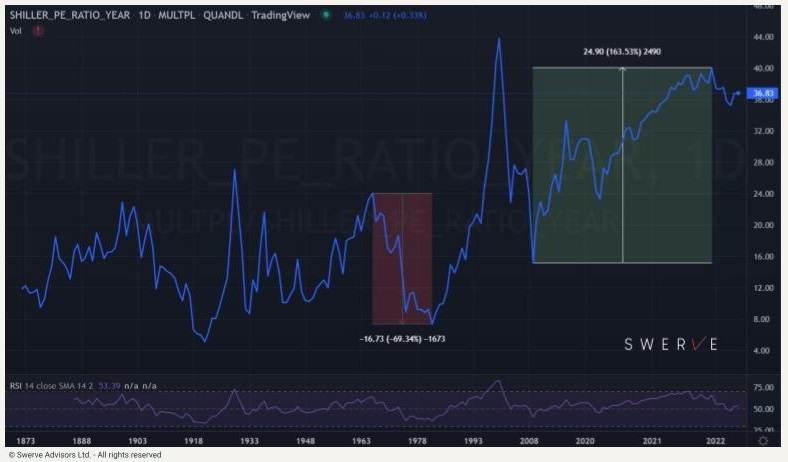Lower PE multiples ahead?
C19 & Ukraine may have set up the stage for a secular repricing of equities. From 2009 to 2021, ever-easier financial conditions brought no real consumer inflation but only new asset bubbles. The conditions are now in reverse as higher interest rates, inflation and supply side constraints are bound to depress valuations.

C19 & Ukraine may have set up the stage for a secular repricing of equities. From 2009 to 2021, ever-easier financial conditions brought no real consumer inflation but only new asset bubbles. Consequently, the S&P 500 multiple’s expanded 164% from 15 to 40 (see chart for the Shiller’s CAPE). The conditions are now in reverse as higher interest rates, inflation and supply side constraints are bound to depress valuations. The shape of things to come may be inferred from the 1965 to 1982 timeframe, also a period of stagnant growth and obdurate inflation. During that time the CAPE declined 70% from 24 to 7 (see chart). If the same decline were to apply to today’s market, the CAPE would fall to 11. FANGs would slip from the current 45 forward PE to the low double-digit and AAPL from 29 to 9, also on a forward PE basis. The level and persistence of inflation will be the key factor to drive such outcome. Stubborn price increases in the mid to high single digit will affect not just policy and the discount of future cash flows but also EBITA margins. A major paradigm shift is ahead for global investors as real returns, rather than nominal, need to be considered; during the aforementioned 1965-1982 period annualized real returns for the S&P 500 were a paltry 0.9%. Dispersions across sectors will become far more significant with declining correlation across sectors as certain industries and companies will fare much better than others. We are already seeing a precursor of that with Energy outperforming Consumer Discretionary or Technology a whopping 60% YTD. Lastly, uber-popular “index investing” strategies, critical to the multiple expansion over the last decades, is going to work precisely in the opposite direction due to the inherent reflexivity of those instruments that magnifies trends and will, , this time, compound the compression of valuations. A wholesale rethinking of portfolios is in order.